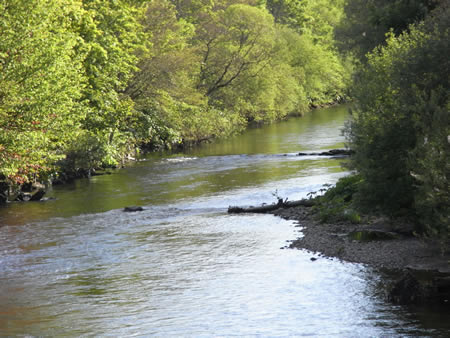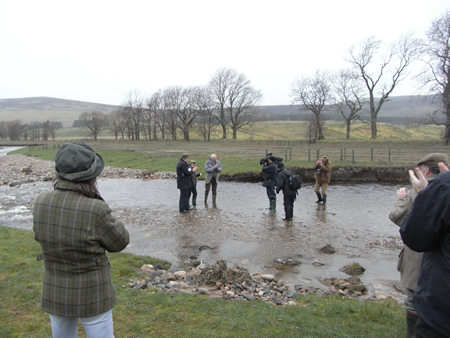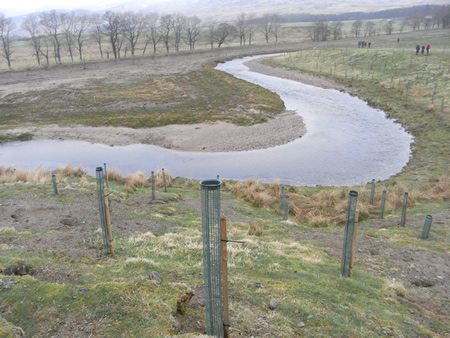These bulletin blogs represent news about Finavon and the South Esk, and my views as a riparian owner. While I may digress at times to write about other places, these are not the views of any other organisation, nor are they designed to promote the interests of any individual or organisation other than Finavon Castle Water and factors affecting the fishery. Tony Andrews
It is two weeks since I last updated this blog space, during which spring salmon have arrived in reasonable numbers off the coast. There has been a good run of MSW salmon, some in the upper teens of pounds, into the North Esk, with some beats such as Pert, The Burn Estate and Stracathro reporting much better catches than a year ago. On the South Esk there are fish well up into the catchment above the meetings, with normal seasonal catches in the middle beats with Kintrockat, Careston, Finavon, Inshewan and Cortachy all catching fish in greater or lesser numbers and Kinnaird doing much better than in recent years, probably because fish have been held back below the dyke by low water temperatures.
If we take the 60+ spring salmon caught on rod and line and in the Marine Scotland tagging net at Kinnaird, the total number of spring salmon caught in the South Esk should be pushing towards 100. While that number is not stratospheric, it is an indication that the spring run – or remnants of what it once was – still exists. Reports of fish seen in the upper catchment, fish lost (at least half a dozen at Finavon), remembering that the water temperature is still struggling to get above 40F (yesterday morning it was 38F) and that April isn’t quite finished yet, we certainly shouldn’t be panicking about the South Esk as the doom-laden Westie report in Trout & Salmon magazine asserts. That report is simply incorrect in stating that this is the worst year ever on the South Esk. I personally would like to read about facts in river reports, rather than the opinions of an individual, especially when those opinions are so far removed from the truth. You only need to look at the long term catch statistics quoted in these bulletins on the 20th of November 2011 to see what I mean.

Beeches Pool (Castle Beat) The photo above was taken from the Aqueduct (now converted to a footbridge) and shows the Beeches Pool where fresh spring salmon have been seen, despite the cold water temperatures, since the middle of March. It is also the pool where John Wood caught and returned a particularly fine salmon of 17lbs (See previous blogs).
Those of us who fish the South Esk regularly know all too well that our spring salmon are not always ready takers of the fly. I have fished over newly arrived fish in the Beeches Pool (Castle Beat) on a number of occasions this year without any perceptible reaction. There is no consensus on the percentage of fish in the river that are catchable at this time of year, but it is probably true to say that on the South Esk it may be a lot less than the 25% quoted for some Scottish rivers. An average percentage of salmon that will respond to the fly, from opinions that I value, would perhaps be about 12.5%. It may be that the percentage is higher when rapalas or other spinning lures are used. Of course this tentative indicator of fish numbers does not take account of fishing effort which on the South Esk, with one or two exceptions, is extremely low. For example, at Finavon the take-up of rods to the end of April was about 15%.

David’s Tree House, the fishing hut on Castle Beat, at daffodil time 2013.
I have repeated in these bulletins over the last three years that we have very little idea of the structure and numbers of the South Esk’s stock of wild Atlantic salmon. That is an accurate statement. We really don’t know. I have made various attempts to find a broad-brush way of indicating numbers, but they all come with a health warning because my methods are at best amateur, but at least they represent an attempt to put numbers on the spring component of the South Esk stock, and they have never been challenged.
We can but make intelligent guesses. Readers will remember the delared catch of 2,307 salmon killed by Usan nets in May 2011, on which I surmised, on the basis of the 2012 Marine Scotland tagging project, that over 750 ‘belonged’ to the South Esk, and the 2500+ salmon from other rivers whose spring salmon were plundered by that indiscriminate mixed stocks fishery. That was just May month 2011, when good numbers of fish escaped the nets and entered the river to provide a show of spring salmon that was “the best since the 1960s” according to some experienced observers. It is not really plausible to claim that 2011 was a one-off year, although I accept that it was a year of an abundance of returning MSW salmon. After all, it takes five years + to produce an MSW spring salmon. In other words, an awful lot of things must have gone right over a period of five years to produce such healthy numbers of spring salmon.
So, in the context of the 2013 season, what could these points indicate?
Here is my tentative list:
1) 2012/13 was a very cold and late winter. Spring water temperatures remain low, and there is plenty more snow to melt. The development of the spring salmon run has been correspondingly slow.
2) South Esk catches to the end of April are about 100 MSW salmon, which at (say) 15% catch rate might indicate 600+ fish already in the catchment.
3) Recent seasons, especially 2011, indicate that the South Esk may consistently be generating a viable spring component. Annual fluctuations in abundance are to be expected in small rivers with variable water levels and temperatures. The South Esk shows over more than 100 years of catch returns that huge variations from season to season have always been the case. While not exactly a spate river, as some on the Scottish west coast are, the South Esk is severely affected by drought at times (as was the case in March and April 2012 when very few spring salmon were caught).
4) Current concern about the spring component of the South Esk stock is encouraging us to adopt a precautionary approach. That must be a good thing in the light of the continuing decline of returning MSW salmon as revealed by ICES. I believe the work being done by Marine Scotland to identify where South Esk springers spawn, and where their progeny spend their juvenile years, is valuable. The fact that the project is also defining the extent of the Usan mixed stocks fishery is a huge bonus.
5) We now await the returns in May because recent years have shown that the bulk of the spring run of MSW salmon takes place in that month. From personal experience and observation I make an assumption that the total numbers of salmon entering the South Esk between 16 February and 31 May averages out in percentages as 1) Feb and March 10% 2) April 20% 3) May 70%. Each of these three periods is affected by water levels and (especially in the early season) by water temperatures. Therefore, if we get a drought in May, we shouldn’t expect many salmon to appear in S Esk rod catch returns. However, it may well be a different story in the Usan net catch returns.
6) We need better data. A stock assemment and management programme for the river has been kick-started by Marine Scotland. I believe we should support that initiative by identifying the most cost-effective means of counting out our smolts and counting in our returning survivors. I think we all know that the only credible way to develop effective management is a) to find out how healthy the South Esk’s stocks of salmon and sea trout are, b) to understand what those stocks comprise in terms of genetic groups (populations) and then start counting…. and continue counting until we are satisfied we have a true picture..
TA on 28 April 2013



